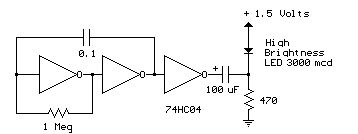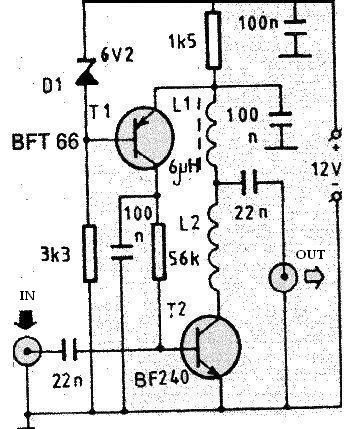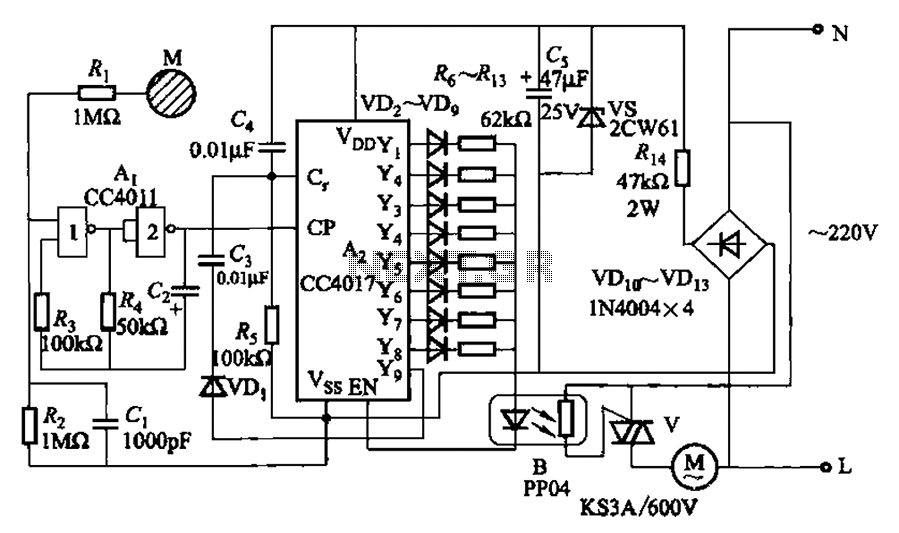
Circuit Diagram Based On The 555 Timer IC

The following circuit illustrates a practical electronics astable circuit diagram based on the 555 Timer IC. This circuit produces a pulse frequency of approximately 2Hz with a very low mark-space ratio, making it suitable for various applications. The single 555 astable configuration is highly versatile. Components used include an integrated circuit (IC), resistor, diode, and capacitor.
The astable circuit utilizing the 555 Timer IC operates in a continuous oscillation mode, generating a square wave output without requiring any external triggering. This configuration is particularly useful in applications such as flashing lights, tone generation, and pulse width modulation.
In this circuit, the 555 Timer is configured in astable mode, which means it alternates between its high and low states. The frequency of oscillation is determined by the resistor and capacitor values connected to the timer. Specifically, two resistors (R1 and R2) and one capacitor (C1) are used to set the timing intervals. The relationship between these components can be described by the formula:
\[ f = \frac{1.44}{(R1 + 2R2) \cdot C1} \]
where \( f \) is the frequency of the output pulse. The duty cycle, or the mark-space ratio, is influenced by the resistor values as well, which can be adjusted to achieve the desired output characteristics.
The output of the 555 Timer is typically taken from pin 3, which can drive loads directly or be interfaced with other circuits. The diode in the circuit may be used for protection against back EMF if inductive loads are connected, ensuring the longevity of the components.
Overall, this astable circuit provides a simple yet effective solution for generating square wave signals, demonstrating the versatility of the 555 Timer IC in practical electronics applications. It is important to select the appropriate component values to achieve the desired frequency and duty cycle for specific use cases.The following circuit shows about Practical Electronics/Plugins/Astable Circuit Diagram. This circuit based on the 555 Timer IC. Features: gives a pulse of about 2Hz with a very low mark-space ratio, used for any number of things, single 555 Astable, plugin is very versatile. Component: IC, Resistor, Diode, Capacitor. [ en. labs. wikime dia. org ] 🔗 External reference
The astable circuit utilizing the 555 Timer IC operates in a continuous oscillation mode, generating a square wave output without requiring any external triggering. This configuration is particularly useful in applications such as flashing lights, tone generation, and pulse width modulation.
In this circuit, the 555 Timer is configured in astable mode, which means it alternates between its high and low states. The frequency of oscillation is determined by the resistor and capacitor values connected to the timer. Specifically, two resistors (R1 and R2) and one capacitor (C1) are used to set the timing intervals. The relationship between these components can be described by the formula:
\[ f = \frac{1.44}{(R1 + 2R2) \cdot C1} \]
where \( f \) is the frequency of the output pulse. The duty cycle, or the mark-space ratio, is influenced by the resistor values as well, which can be adjusted to achieve the desired output characteristics.
The output of the 555 Timer is typically taken from pin 3, which can drive loads directly or be interfaced with other circuits. The diode in the circuit may be used for protection against back EMF if inductive loads are connected, ensuring the longevity of the components.
Overall, this astable circuit provides a simple yet effective solution for generating square wave signals, demonstrating the versatility of the 555 Timer IC in practical electronics applications. It is important to select the appropriate component values to achieve the desired frequency and duty cycle for specific use cases.The following circuit shows about Practical Electronics/Plugins/Astable Circuit Diagram. This circuit based on the 555 Timer IC. Features: gives a pulse of about 2Hz with a very low mark-space ratio, used for any number of things, single 555 Astable, plugin is very versatile. Component: IC, Resistor, Diode, Capacitor. [ en. labs. wikime dia. org ] 🔗 External reference
Warning: include(partials/cookie-banner.php): Failed to open stream: Permission denied in /var/www/html/nextgr/view-circuit.php on line 713
Warning: include(): Failed opening 'partials/cookie-banner.php' for inclusion (include_path='.:/usr/share/php') in /var/www/html/nextgr/view-circuit.php on line 713





